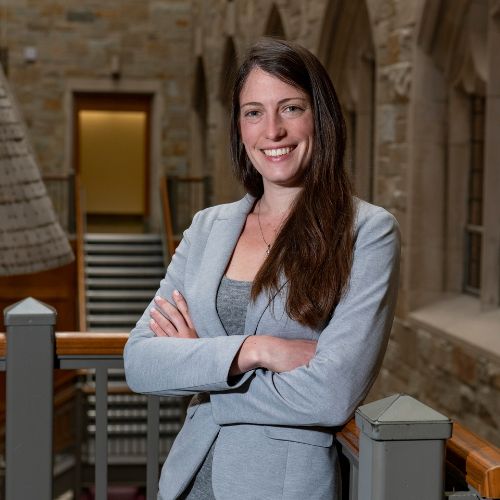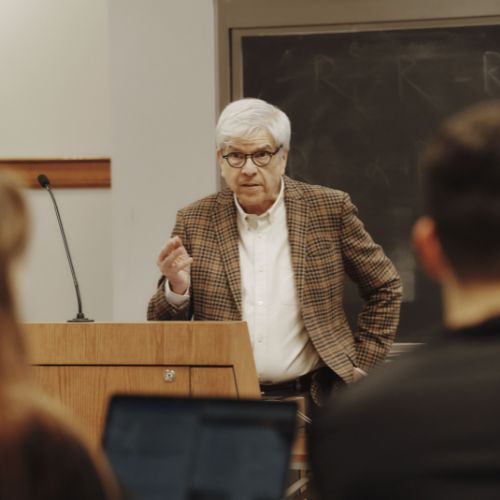Originally published in Carroll Capital, the print publication of the Carroll School of Management at Boston College. Read the full issue here.
A French anti-terrorism unit and an earthquake in China aren’t typical settings for uncovering new managerial insights. But both are backdrops against which Carroll School scholars have lately explored questions that may change how organizations operate. Another setting for several recent research papers—the stock market—is certainly more conventional. But the professors’ findings are just as significant, suggesting better ways of understanding how capital markets really work.

Professor of Management and Organization Michael Pratt
Repairing Trust
An elite French counter-terrorism unit might seem to have little in common with the typical employer, where no shots are fired nor hostages taken. But O’Connor Family Professor of Management and Organization Michael Pratt and a colleague have found that the French commandos, the Groupe d’Intervention de la Gendarmerie Nationale (GIGN), have something to teach all employers about trust and how to repair it in the workplace. “Organizations that use project teams to interdependently handle complex or innovative work, where improvisation may be critical and violations common, are among those contexts where trust is both essential and fragile,” the researchers write in the Academy of Management Journal. The GIGN, unlike many organizations, has formal processes for recognizing and repairing breaches of trust, often encountered in field operations. It also has an ethos that no breach is permanent if the violator is serious about repairing it: “When trust violators successfully went through the standardized process laid out by the organization, they were fully trusted again on subsequent missions.”
More Faculty Research
See a sampling of faculty research, media highlights, and awards from the spring 2024 semester.
A Better Means of Triage
In the aftermath of mass casualty incidents (MCIs) like earthquakes and tsunamis, field hospitals are erected. Traditionally these hospitals have followed the commonsense approach of treating the worst survivable injuries first. But William S. McKiernan ’78 Family Faculty Fellow Nan Liu (Business Analytics) and colleagues have found that a better guideline considers what will happen as the conditions of other patients deteriorate. Using data from the 2008 Sichuan earthquake in China, which killed nearly 90,000 people and injured nearly 400,000, they concluded that prioritizing patients based on an initial assessment of whose conditions will deteriorate (and how they will deteriorate) can produce better overall outcomes. “An MCI response policy to do the greatest good for the greatest number need not always prioritize treatment solely based on victim initial health conditions,” Liu and his coauthors write in Operations Research.
Even Companies Have Feelings
We all prefer those who say nice things about us—and according to research by Joseph F. Cotter Professor of Accounting Mark Bradshaw, Accounting Professor Lian Fen Lee, and a colleague, that’s as true of companies as it is of people. The authors, in The Accounting Review, examine the characteristics of the lists of financial analysts that companies post on their investor relations websites. Analysts, who often work for investment banks, help investors evaluate publicly traded companies. Some companies post the names of analysts that track their performance; others don’t. Such lists are more likely
to appear when, for example, companies are selling stock or receive less media coverage, the researchers say. “We also find that firms are more likely to include prestigious analysts (i.e., All-Stars or employed at larger, more prestigious brokerages) but more likely to exclude analysts who are less favorable about the firm or do not issue consistently beatable [earnings]
forecasts,” they write. “The obvious interpretation is that firms prefer analysts who help portray the firm in a more positive light.”

Finanace Professors Andrey and Nadya Malenko
Laid-back Funds Help Inform CEOs
As index funds have surged, they’ve become controversial. These funds passively own all the securities in a particular market index, instead of buying and selling stocks or bonds as market conditions change. Critics say they undercut the monitoring of public companies: Since they hold stocks regardless of their performance, the funds have no reason to watch over corporate management. But Finance Professors Nadya Malenko (Wargo Family Faculty Fellow) and Andrey Malenko (Hillenbrand Family Faculty Fellow) say that’s wrong. In a paper published in The Review of Financial Studies, the Malenkos and coauthors argue that index funds have an incentive to express their opinions to corporate management because they can’t exit. Actively managed investment funds that disagree with a company’s direction will sell the stock. Since index funds can’t—remember, they must hold all the stocks in an index—they do engage with management. “We show that, as a result, the growth in passive funds can enhance managerial learning from shareholders, increase the informativeness of corporate decisions, and raise the share price,” the researchers write. The Malenkos’ paper examines not just index funds but the broader implications of differences in shareholder and management beliefs and what those can mean for a company’s ownership structure.

Finance Professor Milena Wittwer
Loyalty Benefits Hook Bond Investors
Bonds often trade in what are called over-the-counter markets. An investor who wants to buy a bond contacts a dealer, asks for a price, and, if the price is acceptable, buys. Finance Professor Milena Wittwer and a colleague wanted to know why investors often prefer OTC markets and shy away from centralized exchanges, which, in theory, should be cheaper. “Even though these types of platforms already exist in many OTC markets, investors are reluctant to use them,” they write in the Journal of Political Economy. Using data from Canada’s government bond market, they find that investors receive “loyalty benefits” for transacting directly with dealers in Canada: The dealers provide ancillary services like investment advice “only to customers with whom the dealer has a close business relationship.” Like the free drinks that bartenders bestow on their best customers, those extra services keep investors coming back, even though they’d likely find better prices if everyone used an exchange.
Can Diagrams Improve Decision-Making?
If a picture’s worth a thousand words, might a diagram be worth a thousand dollars—or more? Marketing Professor Min Zhao and colleagues set out to test how visual depictions of options can affect financial decision-making. For many decisions, consumers confront long lists of options—for example, the many policies on an insurer’s website or the many mutual funds offered by an investment company. But long lists can overwhelm. So Zhao and her coauthors, in an article in the International Journal of Research in
Marketing, tested two alternatives: a converging graphic, where multiple options are accompanied by arrows that point to a particular decision, like retirement saving, and a diverging one, where the arrows flow outward from a financial goal, like charitable contributions, to the ways of achieving it. The researchers found that “a financial goal involving inward (versus outward) monetary flow is evaluated more favorably when the goal and its subordinate options are depicted with a converging (versus diverging) diagram.” In other words, converging diagrams can help savers, and diverging ones, givers.
Visit bc.edu/csom-research for more faculty research.






